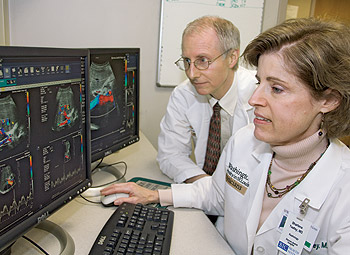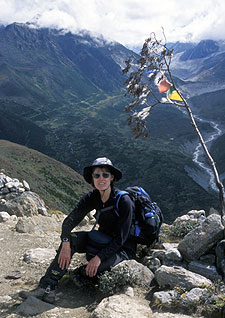Sherry Teefey, M.D., professor of radiology, remembers a moment of panic when she interviewed for her position at Washington University. But it wasn’t the interview that shook her up — it was the view from the Queeny Tower restaurant on the 17th floor.

“I looked out and thought, ‘Oh my God! It’s so flat!'” Teefey says, laughing as she recalls her deer-in-the-headlights reaction. “I love mountains and trekking, and at that time, I was at the University of Washington in Seattle, where there are, of course, mountains, and that was a perfect fit. But I sensed that Washington University was a strong institution with great professional opportunities. Also, the faculty seemed so wonderful. So I bit the bullet.”
A decade and a half later, Teefey remains glad she came to the University. She enjoys both her professional time with patients and colleagues and personal time spent not only hiking in mountain ranges around the world but also in medical education efforts in countries in Africa, Asia and South America.
“Sherry is a truly unique individual who has found a great balance between a productive academic career at the medical school and a full and stimulating personal life outside of the University,” says colleague Bill Middleton, M.D., professor of radiology. “She approaches both with a passion and enthusiasm that are inspirational.”
‘Like fireworks going off’
Teefey was born in Dearborn, Mich. After college, a job opportunity took her to Hawaii, where she ultimately studied at the University of Hawaii, earning her medical degree in 1980. She planned to go into internal medicine and had begun her first year of residency at the Mayo Clinic, but a rotation in radiology during her fourth year of medical school at the University of Utah changed her mind.
“It was like fireworks going off,” she says. “I fell in love with it.”
Teefey realized that radiology also would allow her to combine anatomy and pathology, two subjects she very much enjoyed in medical school. So she finished her first year in internal medicine at Mayo and then switched to radiology. Soon thereafter, she did a fellowship in abdominal imaging, where she honed her skills in the modality that would ultimately become her specialty: ultrasound.
“Everyone thinks that means babies, and my response is, ‘I don’t do windows; I don’t do babies,'” Teefey says, laughing. “But we do almost everything else.'”
Teefey’s main area of research is musculoskeletal ultrasound. She teamed with Middleton and orthopedic surgeons Ken Yamaguchi, M.D., the Sam and Marilyn Fox Distinguished Professor of Orthopaedic Surgery, and Leesa Galatz, M.D., associate professor of orthopaedic surgery, in the mid 1990s. Over the years, the group has published extensively and established the University as a major center of research for ultrasound of the shoulder.
“I have always believed in the multidisciplinary team approach to academics because it fosters clinically relevant research,” Teefey says. “Our team has now grown to include doctors Nirvi Dahiya, Jay Keener and Mike Kim. I can honestly say I am so very fortunate to have such great colleagues to work with.”
Her gratitude extends not only to her colleagues in radiology but also to a second, distinct group of University collaborators involved in improving health care and providing medical education in developing nations.
“I have a very strong passion for international medical education,” Teefey says. “My expertise in ultrasound fits well with this passion because almost every country in the world has an ultrasound machine, regardless of how poor it is.”
‘Essence of nature’
With funding from the Radiological Society of North America (RSNA), Teefey recently traveled to Uganda for two weeks to train radiologists in Doppler and musculoskeletal ultrasound.
Support from the RSNA through an ongoing “Teach the Teachers” grant also allowed her to set up an exchange program in 2001 between the Mallinckrodt Institute of Radiology (MIR) and the Catholic University in Santiago, Chile. The program, which continues today, allows Chilean residents to spend three-month periods observing at MIR and sends MIR faculty to Santiago to teach for one to two weeks.
Teefey also teaches ultrasound and computed tomography in Bhutan, a small Himalayan kingdom east of Nepal and on the border between India and China. Initially, her love of the Himalayas drew her there.

“I have hiked in Europe several times over the years, but I found the Himalayas so immense and majestic,” she says. “They kept drawing me back, perhaps because of the serenity, and the feeling that life was being reduced to the simple essence of nature.”
Her 2001 trip to Bhutan was a test-run for a potential trip to Mount Everest. In 2003, having found that she performed well at high altitudes, Teefey made the trek to Everest base camp, which is 17,600 feet above sea level. (Everest’s peak is just over 29,000 feet above sea level.) Then she climbed 18,400 feet up a nearby mountain, Kala Patar, for a better view of Everest.
Teefey has fond memories of that trip, but the mountain in the photo hanging behind her desk isn’t Everest. It’s a picture she took of Chomolhari, the sacred mountain where she went trekking on her first trip to Bhutan. During that two-week journey, the country captured her heart.
With the help of Jack Ladenson, Ph.D., the Oree M. Carroll and Lillian B. Ladenson Professor of Clinical Chemistry, she has returned to Bhutan twice to teach ultrasound and computed tomography. Colleagues who joined her journeys to Bhutan have included both Ladenson, who worked to improve clinical laboratory services, and David Windus, M.D., professor of medicine, who has helped educate Bhutanese citizens about diabetes and Bhutanese doctors about nephrology.
“Thanks to a very generous donation from General Electric, we were able to provide the Bhutanese with an ultrasound machine with duplex and color Doppler capabilities,” Teefey says. “The scanner arrived at the hospital in mid-March, and I plan to return this spring to help the sonographers and radiologists become acquainted with its intricacies.”
In addition, Ladenson has provided funds to ship much-needed radiology texts and software for a transcription system to the national referral hospital in Thimpu, the capital.
“Sherry is very persistent, which is a good trait to have in this type of work,” says Ladenson. “She’s formed strong personal relationships with the right people in Bhutan and is working with them very closely to enhance their interpretations of radiology results. She’s not only helping them improve their radiological services, she’s also helping them expand and streamline them.”
‘My turn to help others’
Also hanging from the wall in Teefey’s office is a thangka (pronounced ton-kah), a Buddhist scroll painting that depicts Baishajyaguru, the “medicine buddha,” who is the buddha of healing invoked to care for the sick.
“I began reading books on Buddhist and Hindu philosophy when I returned from my first trip to Nepal, and I found the philosophy very much fit with my own personal values,” she says. “Those same principles forged my passion for working in Third World countries. I have been so fortunate throughout my life to have met people who helped me along in my career, and now it is my turn to help others.”
|
Sherry Teefey |
|
Currently reading: “The Tibetan Book of Living and Dying” by Sogyal Rinpoche Also likes to read: Historical novels and history, anthropology and art books
To learn about Buddhism: Teefey recommends any book by the Dalai Lama.
Weekends at home:
Favorite music:
|
Teefey is currently trekking in the Annapurna Sanctuary in Nepal, a glacial basin that leads up to base camp for the Annapurna peaks of the Himalayas. To prepare for these journeys, she “bumps up” her regular three-times-a-week workout schedule.
Teefey also is interested in scenery and wildlife photography in Africa. She has reluctantly surrendered her Nikon SLR camera and is now learning about digital photography.
Other hobbies have included biking and competitive ballroom dancing. At one time, Teefey competed in what are referred to as the “standard” (British) style dances: waltz, Viennese waltz, tango, foxtrot and quickstep.
She has given up competitive dancing for now, though, to spend more time with her mother, June, who has lived with Teefey since her father died.
“It’s very important to me to take care of mom,” Teefey says. “She’s done so much for me, and the personal rewards are so great.”
Other family members include Kathy, Teefey’s twin sister, who lives in Chicago and has a doctorate and a National Institutes of Health grant to study quality of life in heart transplant recipients; Tim, her brother, who is an architect in Michigan; and two nephews and a niece.
Teefey says she loves to drive to work in the mornings through Forest Park and catch glimpses of the sunrise and the birds. She counts herself lucky to have found a house with a small wooded preserve behind it when she first moved to St. Louis. At the end of a long day, when possible, she goes back to nature, sitting quietly on her back porch with a glass of wine, looking up at the stars and “taking life back to the basics.”